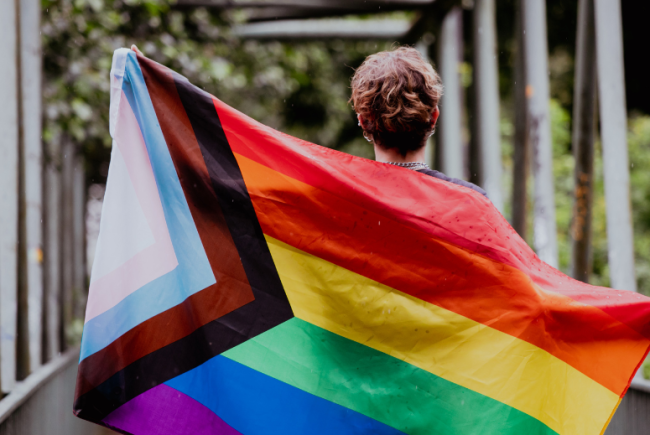You have /5 articles left.
Sign up for a free account or log in.

Emma Rahmani from baseimage
When I entered college, there was no official LGBTQ+ center to welcome me to campus, to offer community or to help me feel a sense of belonging. I had to ferret those resources out myself and was fortunate enough to find them through a newly formed LGBTQ+ student organization. The community I found there helped to positively shape my college experience and future career aspirations.
Colleges and universities today offer a different environment than the one I experienced. But while progress has been made, a study completed by the Point Foundation in collaboration with the Williams Institute at the University of California, Los Angeles, School of Law finds that LGBTQ+ students are still more likely to face bullying, harassment and assault on campus, and more likely to have poor mental health, when compared to their heterosexual and cisgender peers.
Now, with waves of legislation attacking LGBTQ+ rights, education access for students of color and equity and inclusion initiatives, universities can no longer rely on old strategies for supporting students from historically excluded communities. Supporting LGBTQ+ students is particularly difficult when state legislatures are preventing university leaders from identifying and addressing LGBTQ+ students’ needs. The challenge is exacerbated by limited data about LGBTQ+ students’ academic outcomes.
Given these conditions, university leaders may, understandably, feel their hands are tied. Some may think that LGBTQ+ students are a small percentage of the student body whose needs can be addressed largely by interpersonal support from faculty and staff or through student-led LGBTQ+ campus activities. These are false assumptions. Now is the moment for university leaders to invest in deepening institutional awareness of LGBTQ+ students’ experiences and developing innovative supports to address the challenges LGBTQ+ students face.
A Growing Number of LGBTQ+ Students
Make no mistake—LGBTQ+ students comprise more of your student population than you might think. A fall 2022 survey conducted by the American College Health Association, which surveyed more than 33,000 students at 51 institutions, reports that 27 percent of respondents self-identified as lesbian, gay, bisexual, asexual, queer or another non-straight/heterosexual orientation. Transgender and gender-nonconforming students represented 5.7 percent of respondents.
This means as many as one-third of students at your institution could be LGBTQ+ and affected by the increasingly hostile political climate. Whether in the form of the approximately 500 anti-LGBTQ+ hate bills and laws across the country, or the 100+ bills, laws or executive orders censoring curricula on topics like gender, sexuality and race, it’s clear that LGBTQ+ students—and especially trans students and LGBTQ+ students of color—are facing increased challenges.
The impact of this pervasive anti-LGBTQ+ hate is not limited to states with active legislation. While many of the anti-LGBTQ+ bills across the U.S. don’t target higher education, it doesn’t take education-focused legislation for universities to become hostile and isolating environments for LGBTQ+ students. The climate of hostility threatens the physical and psychological well-being of LGBTQ+ people and erodes existing support as institutions pre-empt public scrutiny by quietly removing “diversity, equity and inclusion” from staff titles and programs. I personally know faculty and staff, vocal LGBTQ+ leaders on their campuses, who no longer feel safe being out.
We know that students’ sense of belonging meaningfully affects learning and academic persistence. LGBTQ+ students already had a harder time finding that sense of belonging: the aforementioned Point Foundation and Williams Institute study found that more than 60 percent of LGBTQ+ students report not being out to any faculty and staff members, and nearly 40 percent hear anti-LGBTQ+ comments or slurs in their residence halls. As attacks on diversity and inclusion chip away at training and policies that help protect LGBTQ+ students, we should also anticipate negative effects on academic success and persistence.
Unfortunately, the lack of comprehensive data on LGBTQ+ students makes it impossible to estimate how, and how much, these changes will affect LGBTQ+ students’ academic success and persistence. Sexual orientation is not among the standard demographic data that Title IV–participating universities must provide in annual reporting to the U.S. Department of Education. Yes, sexual orientation is sensitive personal data, and the collection and use of this information must be carefully considered, especially when LGBTQ+ people are under attack. But more data —responsibly collected and reported—are essential for addressing inequity and supporting minoritized students. This information is crucial if we are to understand and support the LGBTQ+ community’s academic success.
How Anti-LGBTQ+ Legislation Affects Higher Ed
Anti-LGBTQ+ legislation affects more than a student’s sense of belonging and academic outcomes—it can also impact recruitment and retention. If an LGBTQ+ person gets accepted to the same 10 institutions across the country as their straight, cisgender peers, they may have to remove half of those options from their list because of the states’ unsafe conditions fostered by anti-LGBTQ+ legislation. This assessment is something LGBTQ+ students are having to do now more than ever, considering that nearly every state has adopted or proposed anti-LGBTQ+ legislation. As the demographic cliff threatens enrollment targets, universities cannot afford to ignore the role anti-LGBTQ+ legislation can have on students’ admissions decisions.
The fact that LGBTQ+ students are having to consider whether they’re going to be safe in a state with hate legislation is especially upsetting because LGBTQ+ students often choose colleges and universities away from their home community or family in order to find more acceptance. The political climate of the country is diminishing the opportunities for LGBTQ+ people to achieve success as they pursue their goals and education in the U.S.
How Can We Help LGBTQ+ Students Now?
- Empower staff and faculty leadership.
Colleges and universities should be empowering staff and faculty members to offer students resources and programming that embrace diverse identities. Empowering staff and faculty to lead programming that students need, and empowering staff and faculty to provide feedback on programming and policy, are ways colleges can create an internal feedback loop based on real student experiences, rather than state politics.
- Elevate and support students’ efforts.
When institutional action is limited by state law or complex political forces, faculty and staff often encourage students to take action. Students’ voices have considerable influence and can spark major change on campuses, and campus activism can contribute to students’ learning and leadership development. That said, students and student organizations are not responsible for ensuring equitable educational access and success. Higher education institutions must provide support and resources.
Resources can take the shape of funding and physical space where it is safe to meet and be open and out on campus. Dedicated faculty or staff members who advise these groups can help with succession or year-after-year student engagement to ensure LGBTQ+ student groups remain a presence on campus, even as group leaders graduate.
Uplift student representation on campus by providing institutional connections to student groups. For example, formalize a channel for students to provide the university with insight into the LGBTQ+ experience on campus and a seat at the decision-making table. Offer students the ability to review and provide feedback on policies that relate to bullying and harassment reporting, diversity training, or bathroom and housing policies on campus. By giving students not only support but also a platform, you can work together on solutions that address the underreported experiences of this large student population.
- Provide your students with resources and information.
If your college is decreasing DEI and LGBTQ+ programming, you can still rely on nonprofits and national organizations to offer resources to students. The Point Foundation has resources and a link library of national resources for LGBTQ+ students. While there is no replacement for in-person community and programming, LGBTQ+ students can still connect and learn online.




